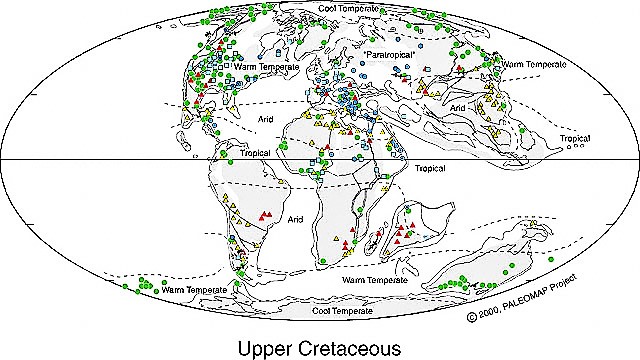The Cretaceous Period, spanning approximately from 145 to 66 million years ago, was a pivotal chapter in the Earth’s climatic narrative, serving as a veritable greenhouse that shielded its inhabitants in a lush embrace. An extraordinary testament to the planet’s ability to nurture life, the Cretaceous epoch was marked by unique environmental conditions that set the stage for the intricate webs of biodiversity that flourished during this time.
In stark contrast to the contemporary climate, the Cretaceous Period experienced significantly warmer global temperatures, averaging between 7 to 12 degrees Celsius higher than today. The term “greenhouse Earth” aptly encapsulates this era, as the atmospheric concentrations of carbon dioxide soared, contributing to a climate teeming with vitality. Despite the absence of ice caps at the poles, the vibrant ecosystems that thrived were not merely a result of the heat; they were a harmonious symphony composed of various elements that played a crucial role in sustaining life.
The oceanic expanses during the Cretaceous were drastically different, resembling vast, undulating tables of tepid water. Shallow seas inundated considerable land areas, creating a network of islands and coastlines that supported an eclectic mix of flora and fauna. These relatively warm waters were rich in nutrients, facilitating the proliferation of not only marine life, such as ammonites and early forms of sharks, but also of sprawling areas of oceanic vegetation. Coral reefs, in their infancy, began to flourish, laying down the groundwork for future marine ecosystems.
As one gazes into the azure depths of the Cretaceous seas, it is easy to envision vibrant, colorful landscapes populated by cephalopods and crustaceans, each one playing a role in the intricate web of life. The bounteous waters served as both a cradle and a canvas, nurturing the complex relationships between species. This dynamic environment fostered the evolution of some of the most iconic creatures, including the notorious dinosaurs, who roamed the supercontinent Gondwana, basking in the opulent warmth.
The terrestrial ecosystems of the Cretaceous were equally compelling. Dominated by dense forests, the landscape boasted a remarkable variety of flora, including ferns, cycads, and the early ancestors of flowering plants. These lush environments created a mosaic of habitats that provided ample food and shelter. The presence of towering conifers and expansive groves imbued the atmosphere with a heady mix of oxygen and humidity, allowing for a lush green tapestry that would captivate any observer.
Yet, the warm climate of the Cretaceous was not devoid of its complexities. The interplay of tectonic activities played a crucial role in shaping the topography of the time, leading to fluctuating sea levels and alterations in climate patterns. The shifting continents of Laurasia and Gondwana greatly influenced ocean currents, which, in turn, affected regional climates. This constant ebb and flow generated microclimates, where some regions experienced arid conditions while others basked in perpetual warmth and moisture.
Intriguingly, the Cretaceous climate was not static but a dynamic entity, characterized by cycles of change that mirrored the broader geological processes at play. Some scientists suggest that the high levels of carbon dioxide were primarily due to volcanic activity, releasing copious amounts of greenhouse gases into the atmosphere. This geological upheaval underscores the interdependence of Earth’s physical processes and climate, a reality the planet now faces as anthropogenic activities continue to reshape its environment once more.
The flora of the Cretaceous period provides even deeper insight into the rich interplay between the climate and the organisms adapting to it. As flowering plants began to appear in greater abundance, they laid the groundwork for a myriad of pollinators, leading to a symbiotic relationship that would mark a significant evolutionary milestone. The emergence of these angiosperms radically transformed terrestrial life, establishing a foundation for ecosystems that would evolve and diversify across millennia.
Not to be overlooked, the Cretaceous skies were also home to an array of atmospheric phenomena, where conditions could shift swiftly from serene to tumultuous. The period saw an increase in storms, which would have influenced sedimentation in the oceans and contributed to the distribution of nutrients necessary for sustaining marine life. The delicate balance between terrestrial and aquatic realms during this era is a reminder that ecosystems do not exist in isolation; they are integrative, multifaceted, and sensitive to the slightest change.
As the Cretaceous drew to a close, a cataclysmic event—the collision of an asteroid with the Earth—ushered in a dramatic shift, marking the end of this verdant epoch. The sudden transition from a greenhouse Earth to a cooler, more arid climate was disastrous for the majority of species that had thrived in the warmth. This great extinction event, often viewed as a foreshadowing of contemporary climate crises, illustrates the fragility of ecosystems and the profound impact of external changes on life’s trajectory.
In retrospect, the Cretaceous Period serves as an intriguing metaphor for resilience and adaptation. Despite the inevitable transitions wrought by geological and climatic shifts, life has an indomitable spirit, evolving to meet new challenges. The lesson here echoes through time, emphasizing the importance of safeguarding our current ecosystems as we confront modern climate change. Just as the ancient Earth adapted, today’s natural world deserves the opportunity to persevere amidst changing conditions.
In examining the climate of the Cretaceous Period, one is reminded of the intricate tapestry of life that thrives in interdependence, highlighting both the wonders of evolution and the critical role of climate stability in fostering biodiversity. Understanding this chapter in Earth’s history inspires both awe and responsibility, urging a collective endeavor to honor and protect the environment in this pivotal age of change.






